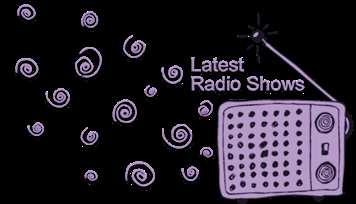
15 minute read
Walking Kaurna countr y
Kaurna Elder and passionate cultural educator Frank Wanganeen (pictured right) has been recognised for his significant contribution to the lives of Aboriginal South Australians though his commitment to reconciliation and the preservation of Kaurna culture and language. He was the recipient of the Premier’s NAIDOC Award for 2017.
Mr Wanganeen is a Kaurna Elder born at Wallaroo on Narungga Country. His mother was living at Point Pearce at the time of his birth, but the local hospital did not allow Aboriginal women to have their children there.
Advertisement
“The closest hospital wouldn’t allow Aboriginal women to give birth to their babies. So the women had to go an extra 60km to Wallaroo to give birth to their children. And it’s unfortunate, some women going up there, they had to give birth on the way up to Wallaroo.” His home of Point Pearce has been through drabmatic changes as government policy changed, Mr Wanganeen explained. “Around ’68 I suppose, that was really a challenging time with legislation that really impacted on a lot of Aboriginal people – self-determination, self-management. “I mean it sounded good, but when they take resources away, it’s like pulling the rug from under your feet, from being a strong community, self-sufficient to seeing people losing their jobs and coming off the mission to Adelaide to get jobs and all those types of things was very unfortunate.” People managed to survive through taking on any employment in Adelaide, Mr Wanganeen said. “It’s all about survival and if you don’t have a job you have to go out looking and of course a lot of them, the skills that they had was like farming, lumping, shearing and doing the council work around the place, so when those sorts of jobs left they had to come into Adelaide and they had to either work down by the wharves doing lumping and other hard labour skills” he said.
Those sorts of challenges make the many achievements of Aboriginal people more noteworthy, Mr Wanganeen believes. “But you see it now there’s a lot of opportunity for Aboriginal people, you can see people becoming nurses, doctors, lawyers. “Now we see more good role models around in our community and that ceiling has really risen, from your expectations of being on a mission. You think, oh you’re just going to be a truck driver or something like that but now the ceiling has risen high.” Mr Wanganeen operates Kaurna Cultural Walking tours and shares his knowledge of the Adelaide area with people interested in Kaurna culture.
“The Adelaide City Council, they’ve dual named a lot of places with the Kaurna language. One site – Tarndangyanga, which is place of the red kangaroo, you know Karra Wirra Pari, which is red gum forest river, and Pilta Wadli, which is the first Kaurna language school down by the weir. And now we incorporate the Aboriginal War memorial, for the soldiers that have fought in all the wars, the Boer War right through to the present wars today” he said. Mr Wanganeen has been involved in the revival of the Kaurna language since early days and marvels at how strong the language has become. “I mean now they’ve got a learners’ guide and they’re using technology with YouTube and so younger people are embracing it. “We’ve just recently had a choir and they’re singing some of their hymns in language, which is good. “It’s really good that people are getting up and singing in language, a lot of people they get overawed by seeing that happening now. Mr Wanganeen is also involved in heritage work across Adelaide. “Well heritage has been really important. Because you get the opportunity to go out on country with our elders. And of course, now a lot of our elders are passing on. And I just see it as those elders passing on the baton to me and that I will eventually want to pass the baton on. “You get to go and see a lot of the country, it’s unfortunate in Adelaide you can’t get access to country a lot because there’s gates and things that don’t allow you to walk country.” Mr Wanganeen is passionate about reconciliation and removing barriers to understanding. “I think it’s important, people are becoming more conscious now, want to know more about Aboriginal culture, now they’re starting to engage and want to hear from Aboriginal people, which is really good. “Like in my journey, you can see the changes and people now wanting to embrace Aboriginal culture, even language, they want to you know name things in their organisations or just in their personal lives, which is good. “Well I always think of it as an opportunity, to be able to build bridges. Because there’s a lot of fear with non-Aboriginal people, you know they don’t know how to approach an Aboriginal person, so its fear. I want to make the most of the opportunity and get in there and hopefully break down those stereotypes that people do have about Aboriginal people and I think it’s only what they see on the media, you know they only see the negative side of Aboriginal people. “So I try and put a different perspective or create an awareness to the nonAboriginal people that we are a part of this community and we want to try and make a difference in our community. “We’re a multicultural society and everybody should be recognised and respected for their own culture” Mr Wanganeen said.

Update from the Anangu Lands Paper Tracker
Advocacy and lobbying
The Anangu Lands Paper Tracker has been very busy advocating and lobbying about a number of issues and government policies, programs and services that affect Anangu communities. In particular, we’ve focused on:
• Amendments to the
APY Land Rights Act In May 2017, the Minister for
Aboriginal Affairs and Reconciliation,
Minister Kyam Maher, introduced the
Anangu Pitjantjatjara Yankunytjatjara
Land Rights (Suspension of Executive
Board) Amendment Bill 2017 into
Parliament, to amend the APY Land
Rights Act. These amendments grant the Minister for Aboriginal Affairs the power to dismiss the APY Executive
Board for whatever reason he/she thinks fit. The amendments to the
APY Land Rights Act were accepted by both houses of Parliament. It is understood that there is currently a High Court challenge regarding these amendments to the Act.
• Community Development
Program (CDP) The Anangu Lands Paper Tracker made a submission and presented to the Senate Inquiry into the CDP and its impact on communities.
• Cashless Debit Card Trials of the Cashless Debit
Card were set up by the Federal
Government in the Ceduna and Far
West Coast communities and in the East Kimberley. Everyone on welfare benefits in these locations has had 80% of their welfare money quarantined – they can only get 20% of their money in cash. This is supposed to stop people using their welfare money on alcohol, drugs and gambling. The Paper Tracker prepared a submission to the Senate
Inquiry about the Social Services
Legislation (Cashless Debit Card)
Bill 2017. The Bill proposes that the trials of the Cashless Debit Card are extended and that new trials can be started in more communities. The submission opposes the extensions and expansions of the
Card because Government has not consulted with the communities who are affected and it does not have reliable evidence to show that the
Trials are helping people with drug, alcohol or gambling problems.
Paper Tracker Radio Shows
The Anangu Lands Paper Tracker has broadcast a range of radio shows, including interviews about the importance of language and interpreting; ways to prevent trachoma; community-based dialysis; the Cashless Debit Card and its impact on communities; the role of the Prime Minister’s Indigenous Advisory Council; Treaty discussions; the NDIS; the high incarceration rate; the Community Development Program (CDP); the Uluru Statement; Alinytjara Wilurara; Aboriginal Community Connect; ear health and hearing loss; the Bikes Palya project; aged care services; and many more.
You can listen to the radio shows at http://www.papertracker.com.au/ category/radio-programs/ We’d love it if you ‘liked’ our Facebook page and posted your comments.
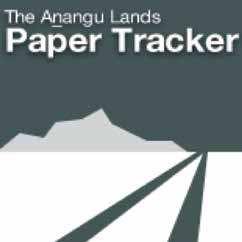
Yankunytjatjara leader and antinuclear campaigner Yami Lester OAM has been farewelled at a state funeral held on his traditional lands at Walatina Station in the Anangu Pitjantjatjara Yankunytjatjara (APY) lands in northern South Australia.
Over 400 people paid their respects to a man celebrated as a survivor and advocate for the victims of nuclear testing, staunch land rights campaigner and interpreter and champion for Anangu.
Family, friends, colleagues, community members and state and federal politicans gathered a stone’s throw from Walkinytanju Creek, where Mr Lester was born 75 years ago. Dignitaries attending included The Governor Mr Hieu Van Le, Premier Jay Weatherill, Minister for Indigenous Affairs Nigel Scullion, Minister for Aboriginal Affairs Kyam Maher, Opposition Leader Steven Marshall and Senator Patrick Dodson.
The Premier said they were gathered to farewell a remarkable citizen of the state.
“Yami Lester was a man of compassion, resilience and warmth. He was dedicated to improving people’s lives and to righting wrongs.”
“By his actions over many decades he has helped us understand the Aboriginal cultures that have enriched this land for tens of thousands of years.”
Mr Weatherill reminded mourners how Mr Lester witnessed the “horror” of British Government nuclear testing at Emu Fields in 1953 and became blind from the effects of those tests as a young man. The Premier recounted Mr Lester’s later account of the tests.
“I heard a big bang, a noise like an explosion and later something came in the air. It was coming from the South with black like smoke. I was thinking it might be a dust storm, but it was quiet, just moving, through the trees and above that. It was just rolling and moving quietly” Mr Lester had described.
For decades Mr Lester kept on speaking up about what had happened to his people, resisting government denial of the impact of the tests.
“In 1982 Yami heard the Chair of the Safety Committee for Emu Fields speak on radio. That man told the listeners that no Aboriginal people had been harmed by any of the tests, in fact they’d all been well looked after” the Premier said.
Mr Lester was angry to hear this and immediately set about raising awareness of the true impact of the tests on Anangu. That work led to the McClelland Royal Commission, which recommended a clean-up operation to restore the country and group compensation.
Those present at Walatina were reminded that Mr Lester was concerned with the welfare of Aboriginal people throughout his life. As a young man he was a welfare worker and interpreter with the Aboriginal Advancement League and later with the Institute of Aboriginal Development (IDA).
Helen Liddle, who worked with him at the IDA recalled Mr Lester as a true leader and good friend.
“He was my mentor, my work mate and my dearest friend” Ms Liddle said.
“Yami was a smart man, a kind man and a man held in high regard.
“I learnt so many things from him and so did many others around him” she said.
It was in his work with the Pitjantjatjara land Council that Mr Lester contributed to the introduction of the APY Land Rights Act by the South Australian Government.
“He’s the one who put the “Y” in the APY lands” the Premier said.
News on Nuclear
Nominations have opened for a Consultative Committee on the possible establishment of a National Radioactive Waste Management Facility near the town of Kimba at the top of the Eyre Peninsula.
The Federal Government has made the announcement as it continues to explore three possible sites for the nuclear waste in South Australia.
They say that the formation of the Kimba Consultative Committee is an important next step in the consultation and technical assessment process for the waste facility which is now underway in the Kimba area. A Community Liaison Officer has also recently been appointed in Kimba.
Two potential sites near Kimba and one site at Barndioota near Hawker are the only locations on the Federal Government’s shortlist for the nuclear waste facility.
Bruce McCleary, General Manager of the National Radioactive Waste Management Taskforce, said that the committee would continue the discussion over the nuclear waste plans.
“This Committee is a key conduit between the community and the Government, and will reflect the successful model already in place at Barndioota” said McCleary.
A Consultative Committee for Barnidoota was established late last year. An Economic Working Group (EWG) has now also been established as part of the Phase Two consultation for the nominated site.
For more information on the Federal Government’s nuclear plans: http://www.radioactivewaste.gov.au/

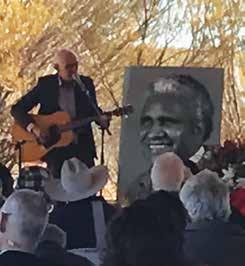
State funeral for Yami Lester at Walatina Station.
He was also there when Uluru-Kata Tjuta was handed back to Traditional Owners, acting as interpreter for the Governor, the Minister for Indigenous Affairs reminded those gathered.
Old friend and Chairperson of Kokatha Aboriginal Corporation Chris Larkin delivered a personal and emotional eulogy at the service.
“I don’t want to tell you about the big achievements – you can Google that” he said.
“I just want to talk to you about how we knew him as a man – my family and his family, and what he meant to us and how he touched us and was an inspiration to us.”
Mr Larkin spoke of Mr Lester’s warmth, bravery and sense of humour.
Mr Lester was an activist against nuclear in any form throughout his life. In recent years he testified to the state Royal Commission looking at establishing a nuclear waste storage facility in South Australia, a plan that has now been shelved. His children continue to carry forward that legacy, with youngest daughter Karina recently addressing the UN on the successful proposal for a nuclear non-proliferation treaty.
Dave Sweeney, anti-nuclear campaigner spoke at the service of Mr Lester’s long activism against nuclear weapons and the pollution from nuclear processing.
“His story is now part of our national story – “I hear I talk, I touch, but I am blind’” Mr Sweeney said.
“In a world without nuclear threats and risks, Yami would have been a great stockman.
“In a world with nuclear threats and risks, he cracked his whip loud, hard, sharp and constant to sound a different alarm.
“And we owe him a great debt” he said.
The service included a performance by singer songwriter Paul Kelly of his 1985 song Maralinga, which was inspired by Mr Lester’s story.
My name is Yami Lester I hear I talk I touch but I am blind My story comes from darkness Listen to my story now unwind This is a rainy land First we heard two big bangs
We thought it was the great snake digging holes Then we saw the big cloud Then the big back mist began to roll This is a rainy land
Yami Lester was laid to rest on his country at Walatina Station.
APY Ar t on show at Tarnanthi Festival
This year’s Tarnanthi Festival of Contemporary Aboriginal & Torres Strait Islander Art has a focus on the seven art centres that span the Anangu Pitjantjatjara Yankunytjatjara (APY) Lands.
Anangu artist Yaritji Young from Amata says the role of an artist is an important one in the APY Lands
“The role of the artist is the same in cities as it is in the bush – it’s a respected position. Artists out here are known for being brave and adventurous, we push new ideas while still protecting and keeping our Tjukurpa (Dreaming stories) strong for our children and grandchildren … this is important for them to see” she said.
The work of the APY artists will appear across the city, including at the Tarnanthi Art Fair on the opening weekend, where collectors will have a chance to to meet and buy works of art direct from artists.
In a major exhibition at the Art Gallery of SA, monumental collaborative paintings created by the matriarchs and patriarchs of the Anangu Pitjantjatjara Yankunytjatjara (APY) Lands in 2016 will be on show.
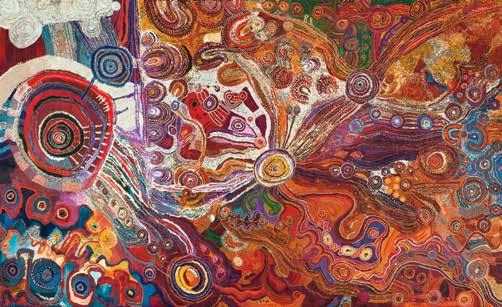
in review
Kulata Tjuta – a work for Kunmanara (Gordon) Ingkatji was created by 23 men, both senior and emerging artists from the APY Lands. This installation includes a large painting and seven kulata (spears) and miru (spear throwers) laid out on the ground as a memorial.
The names of senior men who have passed away are marked onto the miru, including Kunmanara (Gordon) Ingkatji, who spent his life teaching people about Anangu language, law and culture.
Kungkarangkalpa – Seven Sisters, celebrates the shared ancestral Tjukurpa of 24 women artists, both established and emerging.
This immense and vibrant canvas radiates with stories of custodianship, collaboration and Country.
The Tarnanthi Festival opened on 13 October with exhibitions and events in many venues across the city and beyond. For full details visit: https://www.tarnanthi.com.au/
Freda Brady, Wawiriya Burton, Angkaliya Eadie Curtis, Tjangili Tjapukula George, Sandra Goodwin, Beryl Jimmy, Nyurpaya Kaika Burton, Iluwanti Ungkutjuru Ken, Sylvia Ken, Tjungkara Ken, Manyitjanu Lennon, Betty Muffler, Matjangka Nyukana Norris, Mary Katatjuku Pan, Betty Kuntiwa Pumani, Antjala Tjayangka Robin, Alison Munti Riley, Tjariya Nungalka Stanley, Carlene Thompson, Maringka Tunkin, Jeannie Wallatina, Judy Wallatina, Puna Yanima, Yaritji Young, Kungkarangkalpa – Seven Sisters, 2016, Fregon, South Australia, synthetic polymer paint on linen; Acquisition through TARNANTHI: Festival of Contemporary Aboriginal & Torres Strait Islander Art supported by BHP 2017, Art Gallery of South Australia, Adelaide. © the artists, courtesy of Ernabella Arts, Iwantja Arts, Kaltjiti Arts, Mimili Maku Arts, Tjala Arts, Tjungu Palya, photo: Saul Steed.
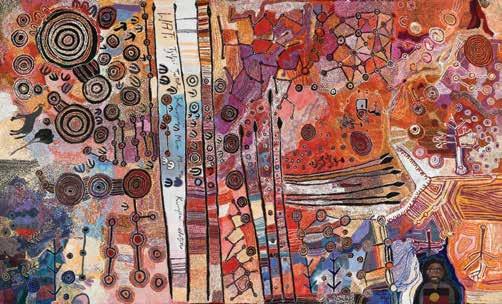
Alec Baker, Eric Kunmanara Barney, Taylor Wanyima Cooper, Pepai Jangala Carroll, Sammy Dodd, Ronnie Douglas, Stanley Douglas, Arnie Frank, David Frank, Witjiti George, Rupert Jack, Willy Kaika Burton, Brenton Ken, Freddy Ken, Ray Ken, Peter Mungkuri, Vincent Namatjira, David Pearson, Jimmy Pompey, Willy Muntjantji Martin, Mick Wikilyiri, Mumu Mike Williams, Anwar Young, Kulata Tjuta – A work for Kunmanara (Gordon) Ingkatji, 2016, Indulkana and Amata, South Australia, synthetic polymer paint on linen and hand-carved wood; Acquisition through TARNANTHI: Festival of Contemporary Aboriginal & Torres Strait Islander Art supported by BHP 2017, Art Gallery of South Australia, Adelaide. Courtesy the artists, Ernabella Arts, Iwantja Arts, Kaltjiti Arts, Mimili Maku Arts, Tjala Arts, photo: Saul Steed.
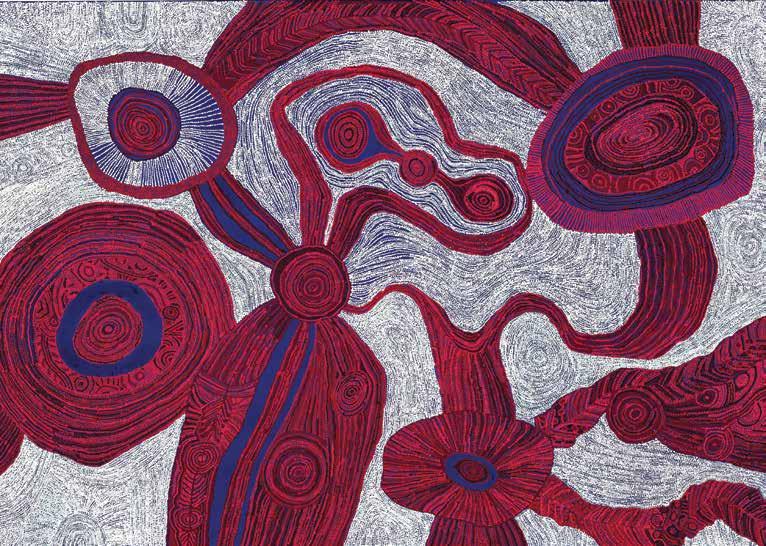
Betty Kuntiwa Pumani, Pitjantjatjara/ Yankunytjatjara people, South Australia, born 1963, Perentie Bore, South Australia, Antara, 2017, Mimili, South Australia, synthetic polymer paint on linen, 300.0 x 200.0 cm; Courtesy the artist and Mimili Maku Arts, photo: Saul Steed.




